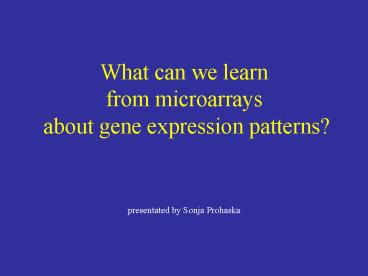What can we learn from microarrays about gene expression patterns - PowerPoint PPT Presentation
1 / 26
Title:
What can we learn from microarrays about gene expression patterns
Description:
reciprocal shift 37 -- 25 (repressed ESR) - osmolarity shift hypo -- hyper & reciprocal shift hyper -- hypo (repressed ESR) Initiation of ESR ... – PowerPoint PPT presentation
Number of Views:40
Avg rating:3.0/5.0
Title: What can we learn from microarrays about gene expression patterns
1
What can we learnfrom microarrays about gene
expression patterns?
presentated by Sonja Prohaska
2
the Biochemistry Departement of Stanford.They
usedDNA Microarray toanalyze changes in the
genomic expression patternsin response to divers
enviromentals stresses
A question also asked by...
3
Measuring transcription levels over time,they
tried to gain information about...
- temporal gene expression patterns after exposure
to stress - dose response to stress
- steady-state gene expression patterns after
adaptation to stress
4
Therefore they had to...
- expose yeast to divers enviromental conditions
- prepare probe and hybridisize to microarray
- compare data
- do hierarchical clustering
- search for sequence motive
5
Therefore they had to...
- expose yeast to divers enviromental conditions
- prepare probe and hybridisize to microarray
- compare data
- do hierarchical clustering
- search for sequence motive
6
expose yeast to divers enviromental conditions
- sudden heat shock (25c to 37)
- hydrogen peroxid (H2O2)
- menadion bisulfite
- dithiothrietol (DTT)
- diamide -gt sulfhydryl-oxidizing agent
- hyperosmotic shock (sorbitol)
- starvetion
7
Therefore they had to...
- expose yeast to divers enviromental conditions
- prepare probe and hybridisize to microarray
- compare data
- do hierarchical clustering
- search for sequence motive
8
Therefore they had to...
- expose yeast to divers enviromental conditions
- prepare probe and hybridisize to microarray
- compare data
- do hierarchical clustering
- search for sequence motive
9
Therefore they had to...
- expose yeast to divers enviromental conditions
- prepare probe and hybridisize to microarray
- compare data
- do hierarchical clustering
- search for sequence motive
10
Therefore they had to...
- expose yeast to divers enviromental conditions
- prepare probe and hybridisize to microarray
- compare data
- do hierarchical clustering
- search for sequence motives
11
Two major responses...
- general response
- to environmental changes
- specific responses
- to specific environmental changes
12
The general response
- environmental stress response (ESR)
- transient changes in expression patterns
- ESR is a graded response
- initiation of ESR
- - when shifted to less optimal environment
- - by divers Regulators
13
The general response
- environmental stress response (ESR)
- transient changes in expression patterns
- ESR is a graded response
- initiation of ESR
- - when shifted to less optimal environment
- - by divers Regulators
14
Environmental stress response
- a set of 900 genes (14) displayed a nearly
- identical expression profile in all samples
- one Cluster repressed
- one Cluster induced
15
- repressed
- growth-related genes
- genes encoding ribosomal proteins (slightly
delayed) - induced
- genes triggering survival in inhospitable
environments - differential expression of isoenzymes
- storage of energy reserves
- synthetic and catabolic enzymes
16
- repressed
- growth-related genes
- genes encoding ribosomal proteins (slightly
delayed) - induced
- genes triggering survival in inhospitable
environments - storage of energy reserves
- synthetic and catabolic enzymes
- differential expression of isozymes
17
isozymes
possible explanations 1) isozymes with
similar function are regulated by different
pathways 2) isozymes with different
properties are adapted to specific
conditions
18
The general response
- environmental stress response (ESR)
- the ESR is a graded and transient response
- initiation of ESR
- - when shifted to less optimal environment
- - by divers Regulators
19
transient changes in expression patterns
- stress causes massive and rapid genome-wide
changes in gene expression which are largely
transient - - serving as a loading dose, providing rapid
- but relativly small alternations in protein
- levels
- - correlated change of protein level, playing
- an important role during the transient
period
20
transient changes in expression patterns
- duration and amplitude of the transient change
vary with the magnitude of the enviromental
change - - so induction of ESR may provide a useful
- operational definition of suboptimal
- environments,
- - and can therefore serve as a molecular
- measure of the level of stess experienced
- by the cell.
21
transient changes in expression patterns
22
The general response
- environmental stress response (ESR)
- transient changes in expression patterns
- ESR is a graded response
- initiation of ESR
- - when shifted to less optimal environment
- - by divers regulators
23
Initiation of ESR
- ESR is initiated in response to transitions to
less optimal environments in contrast to the
reciprocal change - - temperature shift 25 --gt 37
- reciprocal shift 37 --gt 25
(repressed ESR) - - osmolarity shift hypo --gt hyper
- reciprocal shift hyper --gt hypo (repressed
ESR)
24
Initiation of ESR
- ESR is not governed by one all-purpose regulatory
system - - suggested als ESR inducer msn2p, msn4p
- - testing mutants lacking these factors
- provides evidence for alternative
- regulators
25
msn2/4p dependence
The shown cluster is dependent on msn2/4p in
response to heat shock but not in response to
H2O2. Because this cluster is induced through
Yap1p in response to H2O2.
26
What can we learnfrom microarrays about gene
expression patterns?
http//www-genome.stanford.edu/yeast_stress
presentated by Sonja Prohaska































